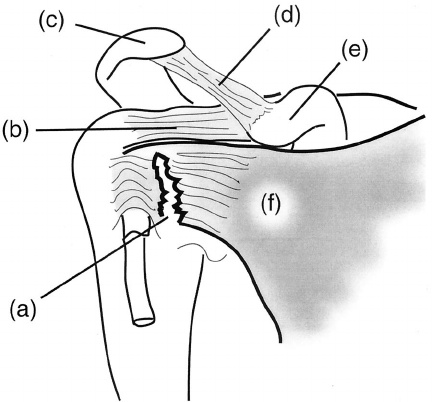Symptoms of subscapularis tear:
The first noticeable symptom of subscapularis tear is shoulder pain, especially in the front of the shoulder. When your arm is rotated, you can feel or hear “clicking”. In general, symptoms of a subscapularis tear are quite similar to other rotator cuff tears. These include:
- pain that gets worse at night
- shoulder or arm weakness
- pain that gets worse when you lift your arm
However, there are a set of symptoms that are unique to this injury. They are the following:
- bicep weakness
- having a hard time reaching for something in your back pocket or reaching for your back
- pain in the space under your collarbone
- your affected arm rotating outwards (palm facing forwards) without you moving it
Causes of subscapularis tear:
An injury to the shoulder generally triggers off subscapularis tear in the young people. This usually happens when your arm is overextended, whereas in elderly people, age-related degeneration leads to subscapularis tear. An impingement in the shoulder can also lead to subscapularis tear as the impingement puts pressure on the subscapularis, leading to tear.
Diagnosis of subscapularis tear:
In the unlikely event, if you are suffering from subscapularis tear, you will experience pain at the front of the shoulder. Moreover, while doing activities of daily living, you will feel weakness, especially while forward lifting and twisting the arm inwards. If you are a sports person, you may feel severe pain in the shoulder while playing. Diagnosis of the tear is generally made, first, by taking a full history. You will be asked if you have hurt your arm of shoulder of late, the specific symptoms you experience and the activities that you find trouble carrying out.
Your doctor may proceed to a couple of tests to narrow down what might be causing the pain. Some of the tests include:
Lift-off test: You will be asked to put your hand on your lower back and then try to lift it. If you can’t lift your hand, it signals a subscapularis tear.
Bear hug test: You will be asked to put the hand of the affected arm on the opposite shoulder. Your doctor will try to pull your hand off your shoulder by rotating your forearm outwards. If you can’t hold your palm on your shoulder or struggle holding it, it also signals a subscapularis tear.
Belly press test: You will put your hand on your stomach and press down, using only your hand (not your wrist or elbow). If this hurts, you might have a subscapularis tear.
The above tests can throw light on what is causing your shoulder to hurt. If your doctor is suspicious, you may be asked to undergo an MRI to make the diagnosis certain as well as to find out the intensity of the tear.
Treatment for subscapularis tear:
Treatment for the tear is tailored based on the tear size and how much the tear negatively impacts your life. Generally the conservative line of treatment is adopted if the tear is small and you can perform your everyday activities. It includes prescribing pain medications, heat, icing etc. For elderly people, physiotherapy is also recommended.
However, if the tear runs deep and across the full thickness of the muscle, you have significant disability from the injury, tear is not improving after about six months of conservative treatment, your doctor might consider surgery.
After the operative procedure, your arm will put in a brace in order to prevent you from rotating the arm outward for about six weeks. After this time period, physiotherapy may be initiated and you can gradually increase your range of motion. After about ten weeks, you can start doing exercises to strengthen your arm.
For enquiries related to Shoulder Pain, Shoulder Injuries, Shoulder Arthroscopy send a message to www.BangaloreShoulderInstitute.com/contact

